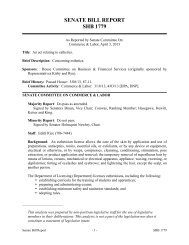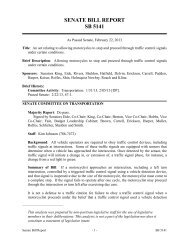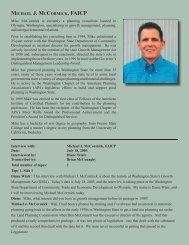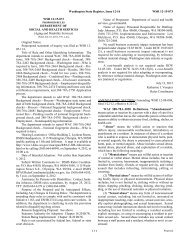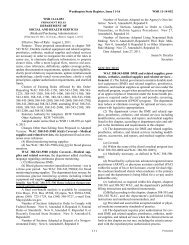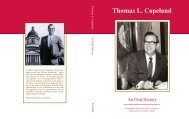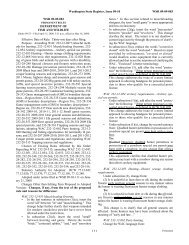Helen Sommers: An Oral History
Helen Sommers: An Oral History
Helen Sommers: An Oral History
You also want an ePaper? Increase the reach of your titles
YUMPU automatically turns print PDFs into web optimized ePapers that Google loves.
Women Advances in Government<br />
In 1883, many in the Legislature who supported<br />
the bill that would grant women’s suffrage were<br />
Eastern Washington farmers, who may have viewed<br />
women voters as a way to clean up the morals of<br />
the territory, Stevenson said.<br />
Elections in 1884 were attended by a greater<br />
percentage of women voters than men. They<br />
helped vote out municipal governments run by<br />
men involved in gambling and liquor and elect<br />
legislators sympathetic to their concerns. The following<br />
year, the Legislature made laws calling for<br />
alcohol education and alcohol prohibition where<br />
local citizens wanted it.<br />
The gambling and saloon lobby began to fear<br />
that women voters would further push prohibition<br />
and that uppity female activities might harm the<br />
territory’s chance to achieve statehood. Suffrage<br />
was bad for business, they argued. In 1888, the<br />
conservative territorial Supreme Court overturned<br />
on a minor technicality the legislation granting<br />
women’s suffrage.<br />
Washington became a state in 1889.<br />
In 1892, state officials needed to choose a flower<br />
that would represent Washington state the following<br />
year at the Chicago World’s Fair. The state’s<br />
fair commission decided that only women would<br />
participate in the election to choose the state flower.<br />
After all, state officials decided, women were<br />
concerned about the beautification of cities. <strong>An</strong>d<br />
they were, along with more serious issues such<br />
as environmental conservation, clean water and<br />
underground sewers (for sanitation and to keep<br />
their long dresses out of the foul-smelling gutters.)<br />
Most women, many of whom had lobbied for<br />
decades for social change and suffrage, were not<br />
offended by the request to choose the state flower,<br />
Stevenson said.<br />
Indeed, the flower election was popular. In<br />
post office polling places from Seattle to Spokane,<br />
women signed their names next to their choice<br />
for Washington’s flower. The ballot included the<br />
rhododendron, dogwood, wild rose, Oregon grape<br />
and clover — a frontrunner.<br />
In her book, Stevenson tells the story of Alsora<br />
Hayner Fry’s support for the rhododendron, which<br />
is native to much of Western Washington.<br />
pg. 247<br />
Fry ran her campaign from a drugstore in downtown<br />
Seattle. To dissuade other ladies from voting<br />
for the clover, Fry set up a store window display of<br />
fresh clover and live bunnies to eat it.<br />
When the ballots were counted, the winner<br />
was the rhododendron. Fry wore a fancy dress<br />
printed with pink rhody blossoms to the state ball<br />
in Olympia the following year.<br />
In celebration of the centennial of suffrage in<br />
Washington, women are again using the rhododendron<br />
as a symbol of enthusiasm for the right to vote.<br />
Women’s clubs in Washington kept the suffrage<br />
movement simmering early in the 20 th century.<br />
Organizations such as the Everett Book Club, as<br />
well as music clubs, ladies’ aid societies and hospital<br />
guilds, taught women how to organize and get<br />
results. Women rode bicycles and began to hike<br />
and climb mountains in the state, proving their<br />
physical abilities and stamina.<br />
<strong>An</strong>d though teaching had for many years been<br />
a career dominated by women, the state now had<br />
three teacher-training schools, and these colleges<br />
were populated primarily by young women who<br />
wanted the right to vote along with their teaching<br />
certificates.<br />
Women were entering the work force in greater<br />
numbers, though many were underpaid. This<br />
disturbed the labor unions, whose members were<br />
worried about losing their jobs to those willing to<br />
work for less.<br />
So, women’s right to vote became a union cause,<br />
too. Labor leaders thought women would surely<br />
vote to support better working conditions, safety<br />
regulations and eight-hour workdays for everybody.<br />
But women also would vote for equal pay for equal<br />
work, and then, the union bosses figured, employers<br />
were sure to hire men instead of women.<br />
By 1908, the suffrage movement was back in<br />
full swing in Washington.<br />
The campaign was funded with quarters pilfered<br />
from grocery budgets, the support of labor unions,<br />
the state Grange and a few churches, and by the<br />
sales of “Washington Women’s Cookbook: Votes



